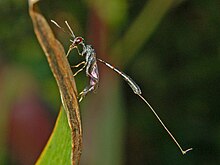| Revision as of 13:12, 22 March 2011 editNotafly (talk | contribs)Autopatrolled, Extended confirmed users, Pending changes reviewers86,194 editsNo edit summary← Previous edit | Revision as of 22:55, 19 April 2011 edit undoViking59 (talk | contribs)Extended confirmed users3,288 editsm interlanguageNext edit → | ||
| Line 39: | Line 39: | ||
| ] | ] | ||
| ] | ] | ||
| ] | |||
Revision as of 22:55, 19 April 2011
| This article does not cite any sources. Please help improve this article by adding citations to reliable sources. Unsourced material may be challenged and removed. Find sources: "Gasteruption jaculator" – news · newspapers · books · scholar · JSTOR (March 2011) (Learn how and when to remove this message) |
| Gasteruption jaculator | |
|---|---|

| |
| Scientific classification | |
| Kingdom: | Animalia |
| Phylum: | Arthropoda |
| Class: | Insecta |
| Order: | Hymenoptera |
| Family: | Gasteruptiidae |
| Genus: | Gasteruption |
| Species: | G. jaculator |
| Binomial name | |
| Gasteruption jaculator (Linnaeus, 1758) | |
| Synonyms | |
| |
Gasteruption jaculator is a species belonging to the family Gasteruptiidae subfamily Gasteruptiinae.
This species is mainly present in the British Isles, Spain, Italy, Austria, Switzerland, France, Germany, Poland, Russia, in the East Palearctic ecozone and in the Near East.

The head and thorax are completely black. The head is strongly rounded, the thorax is elongated in a sort of long neck (propleura), which separates the head from the body. Also the abdomen is strongly stretched, broader at the posterior end and placed on the upper chest (propodeum). The colour of the abdomen is black, with reddish-orange rings. The tibiae of the hind legs are club shaped. In the female the ovipositor is usually very long with a white tip. In resting position, these wasps slowly and rhythmically raise and lower the abdomen.
The adults grow up to 10–17 millimetres (0.39–0.67 in) long and can mostly be encountered from May through September feeding on Apiaceae species.
The females of this parasitic wasp lays its eggs by its long ovipositor on the body of larvae of solitary bees or wasps. On hatching its young larvae will devour grubs and supplies of pollen and nectar of its victim.